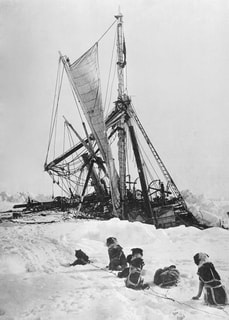 By M.P. Pellicer | Stranger Than Fiction Stories The Endurance was found four miles from where her captain, Frank Worsely reported her going down in 1915. It wasn't only the loss of the ship which made this endeavor so famous, but the tribulations the crew had to endure in order to reach safety. 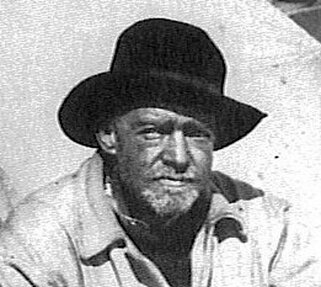 Sir Ernest Shackleton at Ocean Camp, Weddell Sea, 1915 Sir Ernest Shackleton at Ocean Camp, Weddell Sea, 1915 To cross Antarctica from the Weddel Sea via the South Pole to the Ross Seal; this was Sir Ernest Shackleton's dream. He sailed in 1912, from Norway with a crew of 27 men. The year before, Roald Amundsen's expedition was the first to successfully reach the South Pole. Supplies were left on Ross Island at Hut Point. The outpost was built in 1902, during the National Antarctic Expedition led by Robert Falcon Scott. Despite the preparations, nature did not favor the expedition since the ice was denser than normal, and the Endurance became trapped on the Weddell Sea in January, 1915. In February, Shackleton converted the ship to a winter station since he realized she would be stuck until the following spring. The ice was so thick that even under steam power it couldn't make headway. The vessel drifted along for hundreds of miles; its engine silent since it was thought prudent to conserve coal. With warmer temperatures, she was released but it put extreme pressure on the hull. In July, a gale pushed ice into the ship's hull and three months later Shackleton abandoned the ship, moving three lifeboats and supplies to the ice. The Endurance sank on November 21. The 28 men camped on ice floes that drifted northward, living on seal and meat made up by the 70 sled dogs sent for the expedition. They stayed there two months hoping to reach Paulet Island 250 miles away, where there was a cache of supplies. The icy landscape was so inhospitable, that they could not reach their destination. In April, the ice released them and they traveled in open boats to Elephant Island at the tip of the Antarctic peninsula. Chance of being rescued was unlikely since the island was far from any shipping routes. 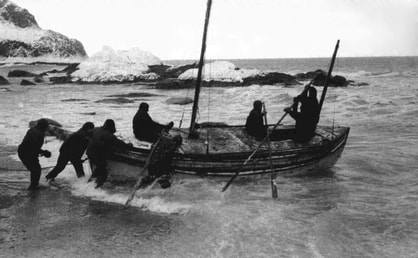 Launching the James Caird from the shore of Elephant Island, c.April, 24, 1916 Launching the James Caird from the shore of Elephant Island, c.April, 24, 1916 Shackleton and five other men then made an 800 mile trip to South Georgia on the 20-foot lifeboat James Caird. Once there, Shackleton took three men with him and crossed the Allardyce Range along the spine of the island. They had no map; and hoped to reach a whaling station at Stromness. They arrived on May 20, 1916, and a rescue effort was immediately organized for men on the other side of South Georgia, and the others on Elephant Island. Three months later they were picked up. They made it home without loss of life. 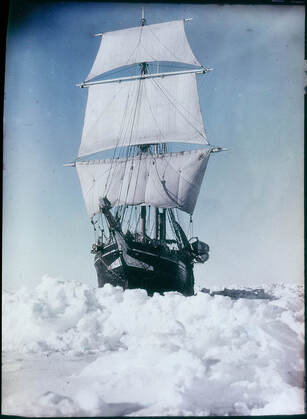 Endurance under sail trying to break through pack ice, Weddell Sea, Antarctica c.1915 Endurance under sail trying to break through pack ice, Weddell Sea, Antarctica c.1915 Sir Shackleton upon his return published his memoirs of the expedition and toured on a lecture circuit. In 1920, he started to think about another expedition. The destination he had in mind was the Artic in the area of the Beaufort Sea, which was largely unexplored. With funds from a former schoolmate he acquired the Foca I, which he renamed Quest. Then he changed his goal, and decided to try to circumnavigate the Antarctic continent, including finding the "lost islands" such as Tuanaki. The expedition left September, 1921. Many of his former crew from the Endurance sailed with their "Boss." When they arrived in Rio de Janeiro, it's suspected Shackleton had a heart attack, but he refused a medical examination. The Quest continued onto South Georgia, arriving January, 4, 1922. A few hours after midnight, Dr. Macklin, the expedition's physician was called to Shackleton's cabin. He complained of back pains, and that he didn't feel well. According to Macklin's diary, he reminded Shackleton the he should try to lead a "regular life". Shackleton asked, "You are always wanting me to give up things, what is it I ought to give up?" Macklin's answer was not new, "Chiefly alcohol, Boss." On January 5, 1922, at 2:50 a.m. Shackleton died from a heart attack. Emily Shackleton, his widow, instructed that her husband be buried in South Georgia, instead of Britain, and on March 5, 1922, he was buried at Grytviken Cemetery. Eric Marshall, the medical officer on the 1907-1909 expedition aboard the Nimrod, made a note in his diary that Shackleton suffered a congenital heart defect known as "hole in the heart" (atrial septal defect). This possibly paired with the strain of the trip caused his death at the age of 47. Shackleton died heavily in debt, and he left his small estate to his widow who died 14 years later in 1936. 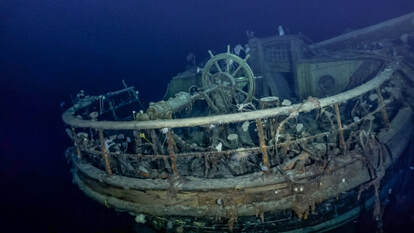 Helm of Endurance c.2022 (Source - National Geographic/Falklands Maritime Heritage Trust) Helm of Endurance c.2022 (Source - National Geographic/Falklands Maritime Heritage Trust) According to The Sun, in 2019, the Endurance22 Expedition tried to locate the vessel, and sent an unmanned sub which was trapped under the ice. With temperatures dipping -18C, the attempt ended in failure. Three years later, Lady Luck was with them, and the ship was located 2 miles below the surface of the Weddell Sea. In a strange twist, the find coincided with the 100 year anniversary of Shackleton's burial on March 5. The New York Times wrote the $10 million cost of the expedition was covered by an anonymous donor. The last years of the 19th century until the end of World War I, became known as the Heroic Age of Antarctic Exploration. Many ships and lives were lost in Antarctic crossings. The HMS Terror and Erebus among others. The Endurance will remain on the seafloor protected by the Antarctic Treaty as a history monument. 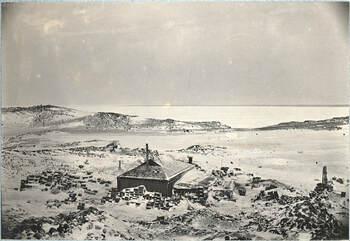 Shackleton's Hut on Ross Island Shackleton's Hut on Ross Island It shouldn't be unexpected that Shackleton is said not to lie easy in his grave, since he possibly felt there was much he left undone. Sir Edmund Hillary (1919-2008), said he met Shackleton's ghost at the Wordie House on Ross Island. The prefabricated hut was shipped from England to Antarctic to house 14 men. Shackleton and his crew built it in 1908. There was an area for dog kennels, horse stables, a meteorological station and a laboratory. It was stocked with canned and dried food, which included mock-turtle soup and raspberries. The supplies were found 100 years after the men left them there. Hillary who climbed Mount Everest said, "I remember when I first went to Shackleton’s hut—and I’m not a person who really sees things very much—but I went inside the door … when I opened the door—it’s a rather sort of bare hut inside—but I distinctly saw Shackleton walking towards me and welcoming me and then it all sort of flashed away and he was gone." There are reports of slamming door, items flying off the shelf and just a creepy atmosphere overall. 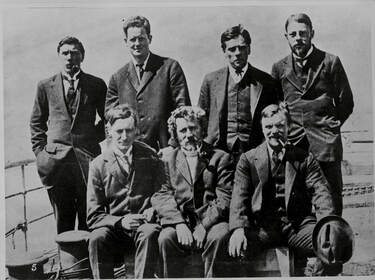 Members of the Ross Sea Party Members of the Ross Sea Party Scientific McMurdo Station on Ross Island is said to be haunted by the ghosts of the 1979 Air New Zealand Flight 901 that crashed into Mt. Erebus. All 20 crewmen and 237 passengers perished in the crash. A worker told the Timaru Herald in 2007 that "ghosts from the Erebus plane haunt the big gym." There's also Scott's Hut, located at Cape Evans. This unlucky group of men belonged to an expedition headed by Sir Robert Scott. In 1911, 25 men wintered in the hut, and left their base camp on a trek to the South Pole. They died on the return trip only 11 miles from reaching a depot. "We shall stick it out to the end, but we are getting weaker, of course, and the end cannot be far," Scott wrote in his final diary entry. "It seems a pity, but I do not think I can write more." Canned food and magazines of the day are still inside. Visitors describe hearing footsteps, shadowy figures, voices and a sensation of being watched. The worse though is a feeling of dread. Behind the hut is a memorial erected to the three members of the Ross Sea Party, a support team sent to deploy depots for Shackleton's Endurance crew. It is just a simple cross. Spencer Smith died of scurvy. Two other members of the Ross Sea Party disappeared into a blizzard after they said they were going to walk to Cape Evans. 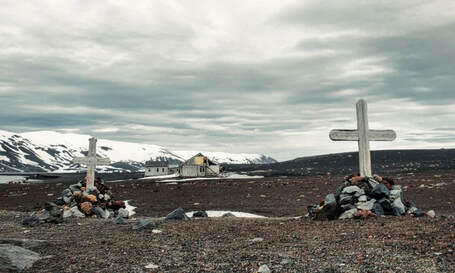 Graves, Whalers' Bay, Deception Island Graves, Whalers' Bay, Deception Island The schooner Jenny left the Isle of Wight in 1823. She was not discovered until 1840, trapped inside an ice-barrier of the Drake Passage. Her last port of call was Callao, Peru. Ironically the whaling ship which discovered it was named Hope. All her crew were aboard, but dead and frozen. The last entry in the log book was dated May 4, 1823, and written by the captain. It read: "No food for 71 days. I am the only one left alive." He was found sitting in his chair holding a pen. There were seven men on the deck frozen solid. Captain Brighton was the first man from the Hope to board the Jenny. There are conflicting reports as to what became of the remains. In one story the crew, the Captain's wife and dog were buried at sea. In another version, all were left where they were found, and only the log book was taken. After being found by the Hope, no one else has come across the ill-fated Jenny. Another haunted place is Deception Island, just off the northwest Antarctic Peninsula in the South Shetland Islands. It offers one of the safest harbors in Antarctica, and it's been both a sealing and whaling station, and in later years a site for science and military bases from different countries. It was abandoned after a volcanic eruption destroyed British Base B in 1969. Present day it is still an active volcano, and research teams visit it only during the summer months. Rusting machinery and structures dot the black sand beaches. There are husks of abandoned places; research station, plane hangars, military bases and equipment from the whaling operation found on Whalers Bay. This is the oldest "ghost town" on the island, used by generations of Norwegian and Chilean whalers. The equipment were left as they were when last used during the 1970s. Present day the island is home to penguins, seals, whales and birds. People no longer live there. The cemetery was buried in the 1969 eruption. In 1906, Whalers Bay was an anchorage for whaling factory ships. In 1931, the bottom dropped out of whale oil, and the station was abandoned. Present day Hektor Whaling Station is a protected historic site and monument.
0 Comments
Your comment will be posted after it is approved.
Leave a Reply. |
Stranger Than Fiction StoriesM.P. PellicerAuthor, Narrator and Producer Archives
July 2024
Categories
All
|
Stories of the Supernatural
- Stories of the Supernatural
- Miami Ghost Chronicles
- M.P. Pellicer | Author
- Stranger Than Fiction Stories
- Eerie News
- Supernatural Storytime
-
Astrology Today
- Tarot
- Horoscope
- Zodiac
-
Haunted Places
- Animal Hauntings
- Belleview Biltmore Hotel
- Bobby Mackey's Honky Tonk
- Brookdale Lodge
- Chacachacare Island
- Coral Castle
- Drayton Hall Plantation
- Jonathan Dickinson State Park
- Kreischer Mansion
- Miami Biltmore Hotel
- Miami Forgotten Properties
- Myrtles Plantation
- Pinewood Cemetery
- Rolling Hills Asylum
- St. Ann's Retreat
- Stranahan Cromartie House
- The Devil Tree
- Trans-Allegheny Lunatic Asylum
- West Virginia Penitentiary
- Paranormal Podcasts
"When misguided public opinion honors what is despicable and despises what is honorable, punishes virtue and rewards vice, encourages what is harmful and discourages what is useful, applauds falsehood and smothers truth under indifference or insult, a nation turns its back on progress and can be restored only by the terrible lessons of catastrophe."
- Frederic Bastiat
- Frederic Bastiat

Copyright © 2009-2024 Eleventh Hour LLC. All Rights Reserved ®
DISCLAIMER
DISCLAIMER
 RSS Feed
RSS Feed
















